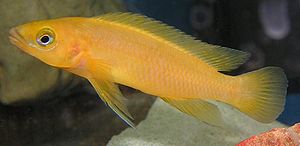Elongated Tanganyika gold cichlid
| Elongated Tanganyika gold cichlid | ||||||||||||
|---|---|---|---|---|---|---|---|---|---|---|---|---|

Elongated Tanganyika gold cichlid |
||||||||||||
| Systematics | ||||||||||||
|
||||||||||||
| Scientific name | ||||||||||||
| Neolamprologus longior | ||||||||||||
| ( Staeck , 1980) |
The elongated Tanganyika gold cichlid ( Neolamprologus longior) , also called gold cichlid, belongs to the family of cichlids (Cichlidae). Its home is Lake Tanganyika in Africa. It is very often confused with the Tanganyika gold cichlid .
Likelihood of confusion
In the past, the elongated Tanganyika gold cichlid was regarded as a subspecies of the Tanganyika gold cichlid ( Neolamprologus leleupi ) and referred to as N. leleupi longior . However, it is now recognized as an independent species. Nevertheless, this species is often still referred to as Tanganyika gold cichlid, N. leleupi or N. l. longior offered.
distribution and habitat
They are typical cave dwellers and so prefer to stay in the craggy rock littoral . The pH value and the total hardness are correspondingly high in Lake Tanganyika.
features
The body of the N. longior is elongated with relatively long pectoral fins. The color is consistently bright yellow to orange, the fins (except for the pectoral fins) can have a dark or light blue border. The bright color diminishes somewhat with age and a darker color sets in, especially around the mouth. Both the iris and a narrow stripe under the eye shimmer light blue. The sexes of the species can only be determined in adulthood and in the behavior of the animals. The animals reach a maximum size of 9 cm. Compared to the similar Tanganyika gold cichlid, the body is significantly more elongated, and there is no kink above the eyes.
behavior
N. longior is a comparatively peaceful Cichlidae that can easily be socialized with other species. With a ratio of 1 fish per 50 liters of aquarium water, there is little rivalry between them. Care should be taken to ensure an equal ratio of males and females, since the weakest surplus females are harassed by both sexes.
N. longior is a monogamous living hole breeders . In preparation for the breeding season, the adult male begins to dig a cave in the fine to 8 mm coarse gravel. Places that can be easily monitored are preferred, e.g. B. between larger stones and aquarium walls. With consistently good water quality, the female will soon be ready to mate after unspectacular courtship by the male. The eggs are preferably laid on the ceiling or the walls and guarded by the female in the cave. The male protects the territory while the female fanned the brood with fresh water by even flapping her fins.
The young hatch after a few days and remain under the care of the female for a few more weeks. Rearing is easy. In order to help the female's willingness to mate a little, a multiple water change of approx. 20% of the tank's content has proven itself. In addition, you can lower the water temperature by 2-3 ° C for a few days and then bring it back to normal temperature.
swell
- Elongated Tanganyika gold cichlid on Fishbase.org (English)
- Hans-Joachim Herrmann: The cichlids of the old world - Tanganyika lake. Ulmer, Stuttgart 1990, ISBN 3-8001-7940-7 .
Web links
- Neolamprologus longior inthe IUCN Red List of Threatened Species 2013.2. Posted by: Bigirimana, C. & Nzeyimana, L., 2006. Retrieved February 9, 2014.